Chesterfield
Explore hidden histories, historic photos, and things you never knew about Chesterfield from the collections and archives of Historic England.
Discover your local listed buildings and places
Introducing some of Chesterfield's most historic sites, included in the National Heritage List for England. Some of these captions have been summarised by AI. Click through for the official List entry. Skip this section and go to place by numbers
Staveley War Memorial
Staveley
First World War memorial, 1920, with later additions for the Second World War. Read the official list entry to find out more.
Queen's Park
Chesterfield
A late C19 public park designed by William Barron and Sons. Read the official list entry to find out more.
Parish Church of St Michael and All Angels
Brimington
Parish church with tower of 1796, remainder rebuilt 1847 by J. Mitchell, chancel refurbished 1891 by Naylor & Sale. Read the official list entry to find out more.
Barrow Hill Primary School
Staveley
Primary School, formerly the Barrow Hill (Mixed) School. 1853-6, with C20 alterations and additions. Built for Richard Barrow, Chairman of the Staveley Coal and Iron Company Ltd.
Parish Church of St John the Evangelist
Chesterfield
Parish church of 1857, with aisles added in 1957. Architect unknown. Read the official list entry to find out more.
2, St Mary's Gate
Chesterfield
2, St Mary's Gate is a 17th-century building noted for its early interiors, including panelled rooms and ornamental plaster ceilings.
Curved Reclining Form (Rosewall)
Chesterfield
Curved Reclining Form (Rosewall), sculpture, 1960-62, by Dame Barbara Hepworth (1903-75). Read the official list entry to find out more.
Brimington Memorial Gates
Brimington
First World War memorial gates erected in 1925, with later additions. Read the official list entry to find out more.
Church of St John the Baptist
Staveley
Parish church of C13-C15, C17 chapel and chancel clerestorey, restored and enlarged 1865-69 by Sir G.G. Scott. Read the official list entry to find out more.
Church of the Holy Trinity
Chesterfield
Parish church of 1838 by T. Johnson, altered 1888-89 by S. Rollinson. Choir vestry 1938. Read the official list entry to find out more.
Church of St Thomas
Chesterfield
Parish church of 1830-31 by Woodhead & Hurst, with chancel 1888 by Naylor and Sale, restored 1903 by Adams. Read the official list entry to find out more.
Roman Catholic Church of the Annunciation, attached presb…
Chesterfield
A Catholic church, begun in 1852 to the designs of Joseph Hansom, altered and substantially enlarged in the late-C19, with C20 and C21 reordering and refurbishment.
Parish Church of St Bartholomew
Chesterfield
Parish church of 1896 by Rollinson. Read the official list entry to find out more.
Explore more
Search for more listed placesChesterfield through time
This timeline shows the first period of use for buildings and places on the National Heritage List for England, just one of the details recorded for every list entry. Click around to see how Chesterfield changes over time. Skip this section and go to aerial photos
Early medieval AD 410 to AD 1066
This period, often associated in England with Anglo-Saxons and Vikings, saw a reduction in urban living from the Roman period and increased migration from northern Europe.
Traces of this period can be found in cemeteries, particularly in artefacts and in some of the very early churches, as this period also saw the growth of Christianity in Britain.
Medieval AD 1066 to AD 1540
This period, sometimes known as the Middle Ages, began with the Norman invasion in AD 1066. It saw a significant rise in military and defensive buildings such as castles and earthworks, as well as religious houses dominating a largely agricultural landscape.
The monarchy and Church dominated the period, which also saw the break with the Roman Catholic Church and the English reformation.
Post medieval AD 1540 to AD 1901
The Post-Medieval period brought seismic changes to life in England, with religious reformation leading to the democratization of worship and the destruction of hundreds of religious houses.
In parallel, there was a huge expansion of scientific study and enlightenment that permanently altered the nation's social structure and landscape. Industrialization and mass production lead to wider global trade, emigration, and immigration.
20th century AD 1901 to AD 2000
The 20th century saw an incredible expansion of England's transport networks, with suburban growth shadowing rapid infrastructural expansion. The establishment of state schools, hospitals, and modern technical colleges, with new architectural styles, radically changed the appearance of towns and cities.
Two catastrophic world wars and the 1918 pandemic also brought unprecedented change, altering England's built environment and social structures forever.
Early medieval AD 410 to AD 1066
This period, often associated in England with Anglo-Saxons and Vikings, saw a reduction in urban living from the Roman period and increased migration from northern Europe.
Traces of this period can be found in cemeteries, particularly in artefacts and in some of the very early churches, as this period also saw the growth of Christianity in Britain.
Medieval AD 1066 to AD 1540
This period, sometimes known as the Middle Ages, began with the Norman invasion in AD 1066. It saw a significant rise in military and defensive buildings such as castles and earthworks, as well as religious houses dominating a largely agricultural landscape.
The monarchy and Church dominated the period, which also saw the break with the Roman Catholic Church and the English reformation.
Post medieval AD 1540 to AD 1901
The Post-Medieval period brought seismic changes to life in England, with religious reformation leading to the democratization of worship and the destruction of hundreds of religious houses.
In parallel, there was a huge expansion of scientific study and enlightenment that permanently altered the nation's social structure and landscape. Industrialization and mass production lead to wider global trade, emigration, and immigration.
20th century AD 1901 to AD 2000
The 20th century saw an incredible expansion of England's transport networks, with suburban growth shadowing rapid infrastructural expansion. The establishment of state schools, hospitals, and modern technical colleges, with new architectural styles, radically changed the appearance of towns and cities.
Two catastrophic world wars and the 1918 pandemic also brought unprecedented change, altering England's built environment and social structures forever.
Aerial photos of Chesterfield
Aerial photography helps reveal secrets of England's changing landscapes that are impossible to see from the ground. Skip this section and go to archive images

Chesterfield
St Mary and All Saints' Church, Chesterfield, 1928

Chesterfield
St Mary and All Saints Church, Knifesmith Gate, Burlington Street and environs, Chesterfield, 1938
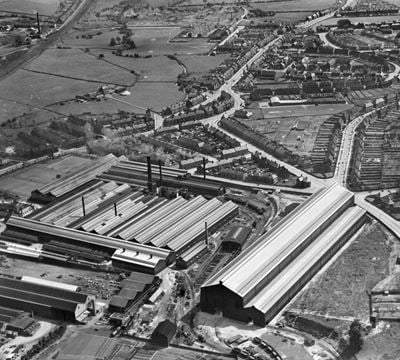
Chesterfield
The Chesterfield Tube Company Ltd Works and environs, Chesterfield, 1938
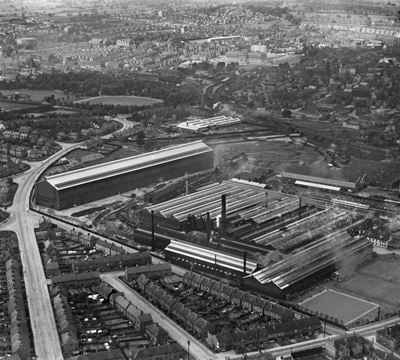
Chesterfield
The Chesterfield Tube Company Ltd Works and environs, Chesterfield, 1938
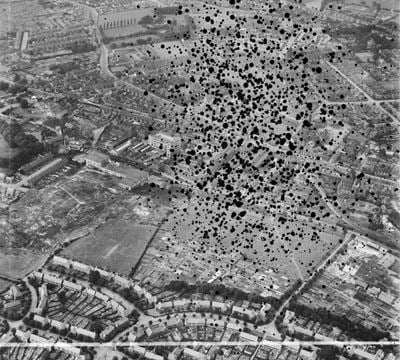
Chesterfield
Sycamore Avenue, Goyt Side Road and environs, Chesterfield, 1949

Chesterfield
The Robinson and Sons Ltd Walton Works and environs, Chesterfield, 1949

Chesterfield
The Robinson and Sons Ltd Wheatbridge Mills (site of) and environs, Chesterfield, 1949
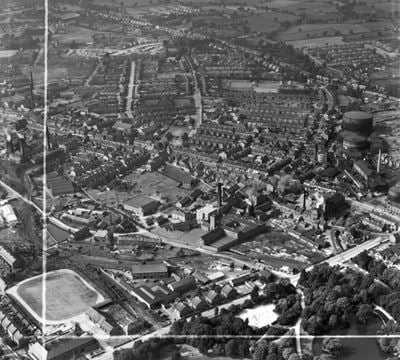
Chesterfield
Wheatbridge Mills and environs, Chesterfield, 1949
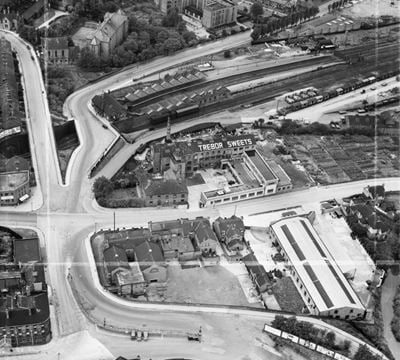
Chesterfield
The Trebor Sweets Factory and Chesterfield Central Railway Station, Chesterfield, 1950
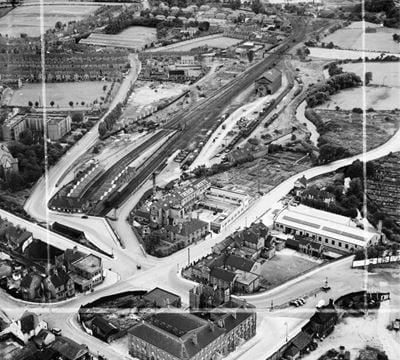
Chesterfield
The Trebor Sweets Factory and Chesterfield Central Railway Station, Chesterfield, 1950
Chesterfield in the Historic England Archive
The Historic England Archive cares for over 15 million images, dating from the 1850s to the present day. Discover stunning images of Chesterfield's past. Skip this section and go to stories about heritage
London, Midland and Scottish Railway Company
Chesterfield, Derbyshire
Date created: Sep 1889
A view looking across the rooftops towards Spa Lane and the spire of St Mary and All Saints' Church
Alfred Newton and Sons
Chesterfield, Derbyshire
Date created: 1896 - 1920
GENERAL VIEW LOOKING NORTH ALONG ST MARYS GATE
Nigel Temple Collection of Postcards of Parks and Gardens
Queens Park, Chesterfield, Chesterfield, Derbyshire
Date created: 1900 - 1930
GENERAL VIEW LOOKING ACROSS TO THE TOWN
Alfred Newton and Sons
Chesterfield, Derbyshire
Date created: 1896 - 1920
GENERAL VIEW LOOKING NORTH ALONG ST MARYS GATE FROM SPA LANE
Nigel Temple Collection of Postcards of Parks and Gardens
Chesterfield, Derbyshire
Date created: 1900 - 1930
GENERAL VIEW SHOWING ALPINE GARDENS WITH CHURCH IN BACKGROUND
Alfred Newton and Sons
Chesterfield, Derbyshire
Date created: 1896 - 1920
EXTERIOR VIEW FROM THE NORTH EAST
Nigel Temple Collection of Postcards of Parks and Gardens
Queens Park, Chesterfield, Chesterfield, Derbyshire
Date created: 1900 - 1920
CHESTERFIELD FROM THE PARK
Alfred Newton and Sons
Chesterfield, Derbyshire
Date created: 1896 - 1920
INTERIOR LOOKING EAST ALONG NAVE
Nigel Temple Collection of Postcards of Parks and Gardens
Chesterfield, Derbyshire
Date created: 1900 - 1930
GENERAL VIEW LOOKING TOWARDS TOWN
Alfred Newton and Sons
Chesterfield, Derbyshire
Date created: 1896 - 1920
INTERIOR SHOWING ALTAR AND EAST WINDOW WITH GEORGE STEPHENSON MEMORIAL VISIBLE
Stories about heritage in your local area
Historic England publishes news, blogs, research, videos, and podcasts celebrating England's rich heritage. Discover the stories we have about Chesterfield. Skip this section and go to education
Pubs, Parks and Pavilions: Victoria in Public Places
Mentions Queen's Park
Here are just some of the historic public places in England named after Queen Victoria.
Heritage and Craft Workers Across England Given a Helping Hand
Mentions Chesterfield
142 historic sites across England are receiving grants worth £35 million through the government’s Culture Recovery Fund.
Public asked to help record a week in lockdown
Mentions Chesterfield
We are calling on you to share images that document your experience of seven days in "Lockdown"
Post-War Public Art Listed
Mentions Curved Reclining Form (Rosewall), Chesterfield
41 sculptures across England designed to bring our public spaces back to life after WWII are newly listed
Chesterfield's social history through photos
Over 10,000 images from the Historic England Archive have been specially selected and re-captioned for teachers, students, and anyone who wants to learn more about their local area. Skip this section and go to grant-aided places
Stephenson Memorial Hall, Corporation Street, Chesterfield, Derbyshire
Period: Edwardian (1902 - 1913)
Built in 1879 by public subscription as a memorial to George Stephenson, railway pioneer, who lived at Tapton Hall, Derbyshire.
Stephenson Memorial Hall, Corporation Street, Chesterfield, Derbyshire
St Mary And All Saints Church, St Marys Gate, Chesterfield, Derbyshire
Period: Victorian (1837 - 1901)
St Mary's is a large medieval church built of ashlar stone. It has a nave, aisles, north and south transepts and a chancel.
St Mary And All Saints Church, St Marys Gate, Chesterfield, Derbyshire
St Mary And All Saints Church, St Marys Gate, Chesterfield, Derbyshire
Period: Edwardian (1902 - 1913)
Looking north along St Mary's Gate from Spa Lane.
Parish Church of St Mary and All Saints, St Mary's Gate, Chesterfield
Period: Medieval (Middle Ages) (1066 - 1484)
A large medieval church built of ashlar stone. It has a nave, aisles, north and south transepts and a chancel. The chancel has 4 chapels around it.
Parish Church of St Mary and All Saints, St Mary's Gate, Chesterfield
Odeon Cinema, Chesterfield, Derbyshire
Period: 1930s (1930 - 1938)
The Picture House opened in 1923, became an Odeon in 1936, and closed in 1981.
Odeon Cinema, Chesterfield, Derbyshire
National Union of Miners Offices, 100 Saltergate, Chesterfield, Derbyshire
Period: Victorian (1837 - 1901)
The purpose built union offices and accommodation for the General Secretary date from 1893.
National Union of Miners Offices, 100 Saltergate, Chesterfield, Derbyshire
Former Chesterfield Grammar School, Chesterfield, Derbyshire
Period: Victorian (1837 - 1901)
A school was first recorded in Chesterfield in the 13th century. This building dates back to 1846 and was originally Chesterfield Grammar School.
Former Chesterfield Grammar School, Chesterfield, Derbyshire
Engine Shed, Campbell Drive, Staveley, Derbyshire
Period: Victorian (1837 - 1901)
A locomotive 'roundhouse' or engine shed dating from the 1870s.
Engine Shed, Campbell Drive, Staveley, Derbyshire
Discover more
Ready for more local heritage? Take a look at these other places nearby
North East Derbyshire
Local Authority District
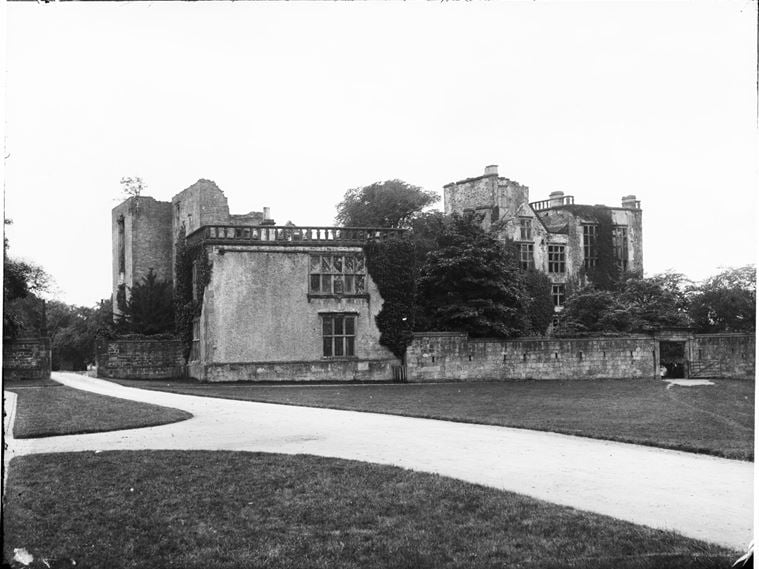
Bolsover
Local Authority District

Derbyshire
Ceremonial County